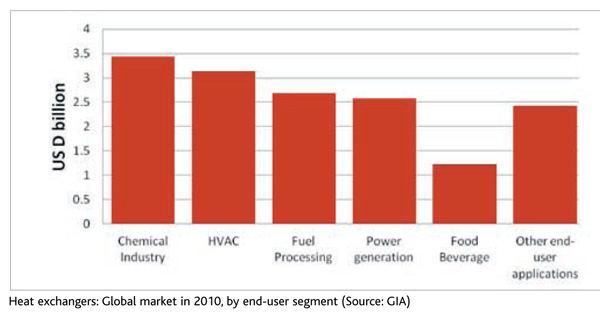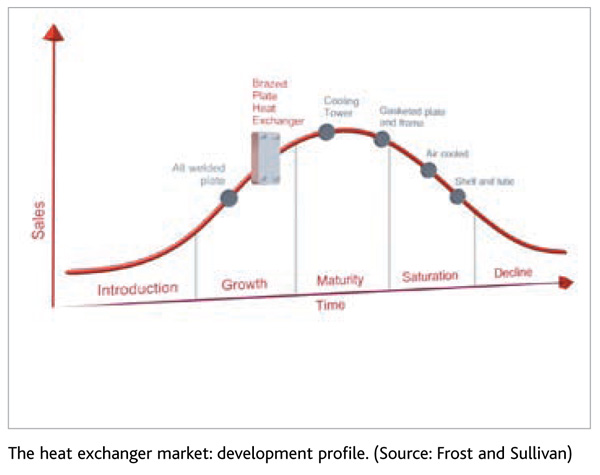Spurred by a clamour for energy efficiency and smaller installation footprint, brazed plate heat exchangers in HVAC applications will gain market share, says Shwan H Lamei.
Spurred by a clamour for energy efficiency and smaller installation footprint, brazed plate heat exchangers in HVAC applications will gain market share, says Shwan H Lamei.
Heat exchangers are essential components in thermal systems used worldwide in many modern industrial and engineering applications, ranging from automotive, aerospace, and commercial building HVAC to heating, cooling, and heat-recovery applications in industrial plants. This article focuses on the market outlook and drivers for heat exchangers used in HVAC applications over the coming years.
Global Industry Analysts, Inc (GIA) reports that the chemical industry and HVAC applications are the two largest end-user segments (see graph, below).

The rising graph for heat exchangers
An increasingly mature global heat exchanger market is being spurred by a decade of gradual technological improvements. GIA expects improvements in energy efficiency, total lifecycle costs and durability to emerge as key differentiating factors over this period. One particular market driver is rising land prices in the world’s cities, which is strongly encouraging the adoption of more compact heat exchanger solutions.
Developing countries will account for much of the growth in the global heat exchanger market. Growth rates in emerging nations in the Asia-Pacific, Latin America, and Middle East regions are encouraging, but GIA points out that low penetration rates mean that this growth comes from a much smaller base. GIA expects Europe’s share of the global heat exchanger market to fall from 30% (2004) to 27% by 2018, with a similar trend for the US market. The Asia-Pacific region will have become the world’s largest market by that time.
Rising energy price is a powerful driver of the more efficient use of energy. This is particularly true for HVAC applications, where heat exchangers with greater efficiency offer an attractive route to savings. However, there is a more general impetus towards energy efficiency and lower heat energy costs worldwide, and GIA concludes that heat exchangers will emerge as the greatest beneficiaries of the energy saving industry that is now rapidly emerging.

Challenges
The heat exchanger market, however, faces challenges, such as the recent F-gas (fluorinated greenhouse gases) regulations, which will have a profound impact on, among other things, heat exchangers used as evaporators and condensers in chillers.
In November 2012, the European Commission proposed important changes in the F-gas regulations: The banning of hydrofluorocarbon gases (HFCs) in some applications, and the reduction in the EU’s use of F-gases to 21% of the 2008-2011 average, with the proposals being implemented stepwise over the period from 2015 through 2030. Furthermore, HFC refrigerants will be allowed only if the systems concerned satisfy Eco- Design criteria. Similar developments are being debated in the United States (SNAP, Significant New Alternative Policy) and China.
In one-phase HVAC applications, such as district cooling and heating, the compactness of heat exchanger solutions is seen as a major differentiating factor, alongside the ability to adapt to future demands for thermally longer heat exchangers. With labour costs increasing, maintenance and lifecycle costs are similarly expected to gain importance.
Demands for energy efficiency and compactness have made plate heat exchangers (PHEs) the fastest-growing heat exchanger technology over the past few decades. Brazed plate heat exchangers (BPHEs), an evolution of the PHE concept, further reduce weight and footprint, and are expected to continue to gain market share. Putting this into a wider context, Frost and Sullivan (see diagram) regard BPHEs and all-welded PHEs as the only two technologies in the growth phase of their product lifecycles.
Although one past limitation of BPHEs has been the ability to produce units with bigger sizes handling high-flow rates, the technology to overcome the production limitations has been developed. High-capacity units are now in production, and as a result BPHEs have continued to win market share from older technologies.
The road ahead
Looking ahead, the heat exchanger industry will offer the HVAC market incremental improvements in weight to capacity efficiency, accelerated by increasing material costs and the demand for smaller units to minimise the footprint of installations. Parallel to this, products will need to be aligned with and optimised for new environmentally friendly refrigerants and high efficiency systems.
The writer is Segment Manager, District Energy, Department Marketing & Sales, SWEP International AB. He can be reached at: shwan.lamei@swep.net
REFERENCE
Copyright © 2006-2025 - CPI Industry. All rights reserved.